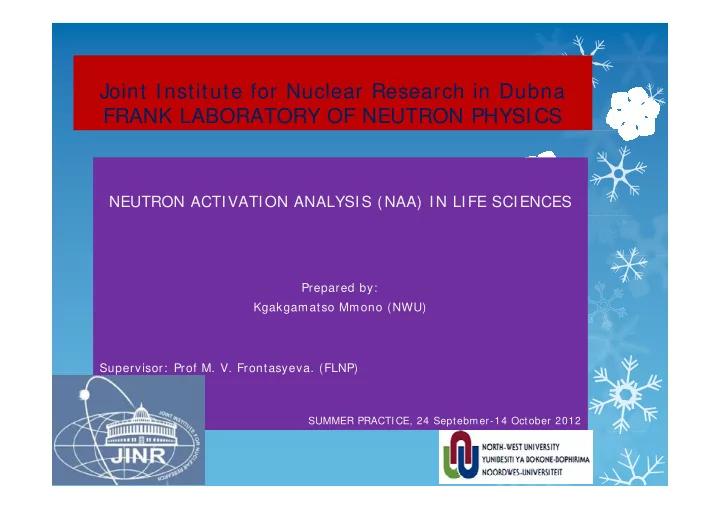

Joint Institute for Nuclear Research in Dubna FRANK LABORATORY OF NEUTRON PHYSICS NEUTRON ACTIVATION ANALYSIS (NAA) IN LIFE SCIENCES Prepared by: Kgakgamatso Mmono (NWU) Supervisor: Prof M. V. Frontasyeva. (FLNP) SUMMER PRACTICE, 24 Septebmer-14 October 2012
OUTLI NE 1. I ntroduction 2. Neutron Activation Analysis 3. Gam m a-Spectrom etry 4. Applications of NAA at I BR-2 5. Absolute Method 6. Conclusion
1. INTRODUCTION - I l ґ ja Mikhailovich Frank (1908-1990) - Founder of FLNP at JI NR (1956) - The Nobel Prize winner in Physics (1958) PIONEERS OF NAA George de Hevesy 1885-1966 Hilde Levi 1909-2003 The Nobel Prize in Chemistry 1943
2. NEUTRON ACTIVATION ANALYSIS - NAA was discovered in 1936 when Hevesy and Levi found that samples containing certain rare earth elem ents becam e highly radioactive after exposure to a source of neutrons. - It is a sensitive multi-element analytical technique used for both qualitative and quantitative analysis of major, minor, trace and rare elements in samples from almost every field of scientific or technical interest.
� � � (a). NAA Methods Relative Method usually performed by firstly irradiating known amounts of the sample and element standards simultaneously followed by comparing their gamma ray spectrums counted under the same conditions. k o -standardization method is based on irradiation of a sample with a neutron flux monitor such as gold and the use of a nuclear constant called the k o -factor. The absolute method is a direct analysis of the irradiated samples without using any element standard reference.
Relative Method � The NAA the method Performed at IBR-2 Reactor � the activity can be given by : [ ] − = 1 . . A A m C H s R S S R
(b). NAA Principle Neutron Flux Spectrum - Thermal (0,025 eV – 0,5 eV) - Epithermal (0,5 eV – 10 keV) - Fast (10 keV – 25 MeV)
� � NEUTRON FLUX Differences in neutron flux between samples and reference elemental standard can be corrected using flux monitors. The normalised activity values are used to calculate the concentration in the sample by : [ ] [ ] = . . C C m m A A ( ) ( ) s R R S norm s norm R
( c) . I BR-2 Pulsed Fast Reactor REGATA REGATA C h4 C h3 C h0 BS C h1 C h2 C d S BS SM R C B DC V L U 32 SU d28 R d28 R 1 d16 D D D R 2 IBM C C A A PC C B R 3
( d) . I NAA Procedure Sample preparation . . Neutron irradiation of samples Decay of radioactivity Decay of radioactivity Decay tim e Decay periods between Decay periods between 15s – 7 days 15s – 7 days Count Measurement of γ -ray spectra of samples and standards with HPGe-detector Measurement of γ -ray spectra of samples and standards with HPGe-detector tim e Evaluation of the γ -ray spectra Evaluation of the γ -ray spectra using a computer program using a computer program Calculation of element Calculation of element content giving results content giving results in µg/ g in µg/ g 10
(e). Sample Preparation Chemical laboratory of the dept. NAA and Applied Research and some equipment for sample preparation.
3. GAMMA SPECTROMETRY Detector Detector Calibration
4. APPLICATI ONS OF NNA AT IBR- 2
Logic diagram of software for automation of NAA
� � � 5. THE ABSOLUTE METHOD Consists of absolute gamma ray measurements and direct calculation of the element concentrations with the help of reactor core simulations and available nuclear data Investigated at SAFAR-I Research Reactor Monte Carlo N-Particle (MCNP), Fispact
� � 6. CONCLUSIONS Neutron Activation Analysis (NAA) is a useful method for the simultaneous determination of major, minor and trace elements of geological, environmental and biological samples in ppb-ppm range with or without chemical separation. Automation of neutron acti vation analysis will im prove the quality of the laboratory and as well increase the quantity of the samples analysed in the department of neutron activation analysis & Applied Research(DUBNA).
Recommend
More recommend